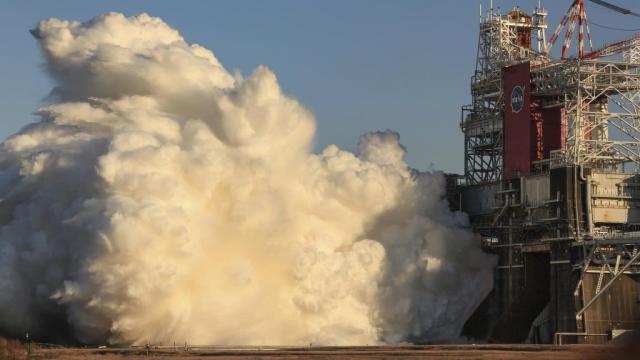The recent hotfire test of NASA’s next-gen megarocket was supposed to go for eight minutes, but it lasted just 67 seconds. The space agency has an explanation for the premature shutdown, saying everything’s swell, but a second test remains a distinct possibility.
The first hotfire test of the Space Launch System (SLS), performed on Saturday, January 16 at NASA’s Stennis Space Centre in Mississippi, came to a grinding halt at just over the one-minute mark when a key parameter went into out-of-bounds territory, explained NASA in a statement. The parameter in question has to do with the hydraulics required for gimbaling, or the pivoting, of each rocket engine.
For the test — the eighth and (maybe) final of the Green Run testing regime — NASA planned to fire all four of the rocket’s RS-25 engines for up to eight minutes. With the 65-metre tall rocket stage anchored to the B-2 test stand, and with the core stage filled with more than 2,649,787L of propellant, the engines sprung to action at 5:27 p.m. EST, spewing a gigantic cloud of exhaust. This lasted for exactly 67.2 seconds until computers shut the whole thing down.
NASA has reviewed the data and done preliminary inspections of the system, finding that the rocket’s hardware is in “excellent condition” and that the shutdown “was triggered by test parameters that were intentionally conservative to ensure the safety of the core stage during the test.”

Built by Boeing, SLS will be NASA most powerful rocket and a key component of the upcoming Artemis missions to the Moon. It consists of a core stage with four RS-25 engines, along with two smaller solid rocket boosters attached to each side à la the Space Shuttle Program. Once operational, SLS will be used to send American astronauts to the Moon at some point during 2020s. An uncrewed inaugural launch could happen later this year.
Speaking to SpaceFlightNow, outgoing NASA chief Jim Bridenstine said NASA “might be able to take the rocket down to Kennedy [Space Centre in Florida] and get it ready for launch,” adding that this “decision has not been made,” as the situation remains uncertain.
Indeed, NASA is still trying to determine if a second hotfire test will be required. Given the results of the first test, the team could tweak the thrust vector control parameters to prevent a similar shutdown, according to NASA.

The pre-programmed parameters for the hotfire test are specific to ground testing, and they’re designed such that the core stage’s thrust vector control system can safely adjust the orientation of the RS-25 engines. In addition to the thrust vector control system, a series of actuators provide the forces required to gimbal each engine, and they’re powered by multiple Core Stage Auxiliary Power Units (CAPU). The gimbaling of the engines worked as planned, but the associated hydraulic system “exceeded the pre-set test limits that had been established,” resulting in the shutdown, according to NASA.
NASA says this is not a problem, and had SLS been in flight, the rocket would’ve continued along its journey using the remaining CAPUs. And in fact, NASA said the abbreviated test actually demonstrated this in action.
What’s more, the gimbaling test that shut down the CAPU was an “intentionally stressing case for the system that was intended to exercise the capabilities of the system,” said NASA. “The data is being assessed as part of the process of finalising the pre-set test limits prior to the next usage of the core stage.”
In terms of positives, it was the second successful wet test (i.e., the rocket was fully loaded with propellant), the team was able to pressurize the propellant tanks, and they completed a countdown leading to the ignition of the engines. At full blast, the engines reached their maximum capacity at 1.6 million pounds of thrust.
[referenced id=”1660081″ url=”https://gizmodo.com.au/2020/12/nasa-completes-wet-dress-rehearsal-of-its-most-powerful-rocket/” thumb=”https://gizmodo.com.au/wp-content/uploads/2020/12/23/q60rbkpkkzp1ydxpuk2w-300×169.jpg” title=”NASA Completes ‘Wet Dress Rehearsal’ of Its Most Powerful Rocket” excerpt=”Engineers from NASA and Boeing have added cryogenic propellants to the core stage of the Space Launch System (SLS), reaching a major milestone in the development of this advanced rocket.”]
The team will continue to investigate apparent flashes seen around the engines. Thermal blankets used to protect the engine from the intense heat showed signs of scorching, which isn’t strange given their proximity to the engines and CAPU exhaust. Still, NASA wants to be sure this was normal behaviour.
As noted, a second hotfire test is not out of the question. As reported in SpaceFlightNow, John Shannon, SLS program manager at Boeing, said the team wanted to acquire and evaluate at least 250 seconds of data during the test before proceeding to the next stage. Obviously, a full eight-minute test would be even better, as that’s the total length of time it will take the SLS rocket to reach space.
Yes, this would present a potential delay, but there may no longer be any rush. It’s not clear if the Biden Administration will require NASA to reach the lunar surface in 2024, an accelerated timeline pushed by the Trump administration.
